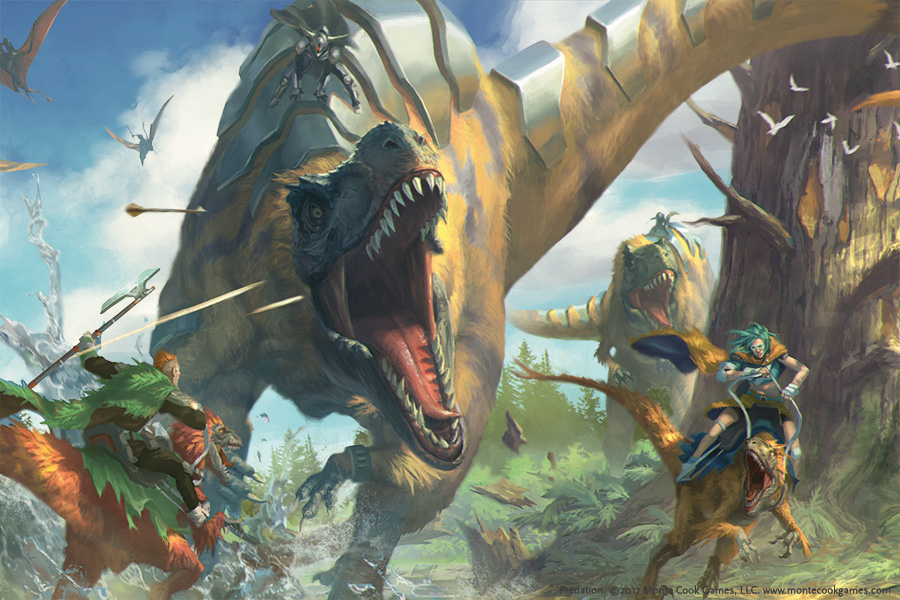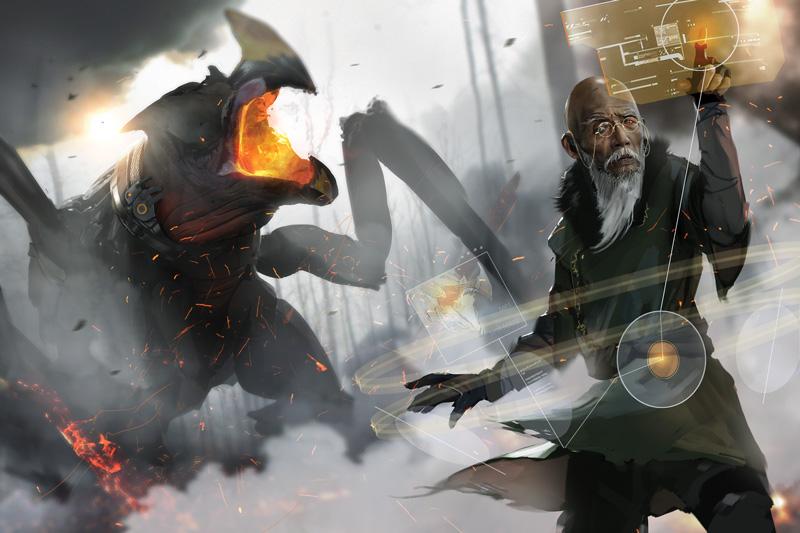The helicarrier is falling. Iron Man is spinning the turbine to restart it, as Captain America stands by to deactivate the electromagnet. Suddenly Cap, dodging bullets, slips on some debris. He teeters at the edge of the scaffolding, then tumbles into the open air! Fortunately he falls into a mass of dangling cables—but can he climb back in time to save his friends?
One of our favorite things about the Cypher System is the GM intrusion. It’s a great tool that helps the GM inject that sort of high drama and excitement into any encounter. But how do you get the most out of them?
First, let’s look at how they can help shape your game. Say your PCs are in a dungeon. An ogre has chased them into a small room and the only other exit is locked. The ogre is bashing at the door. In some games, the GM might make a strength roll for the ogre—either it breaks through, or the PCs are safe. Or maybe the GM ups the tension with a d6 roll each round—on a 1, the ogre breaks through. Will the rogue get the door unlocked in time? Will the other PCs have time to set up a good defense? It’s down to the roll of a die.
But not in the Cypher System. In the Cypher System the GM decides that the ogre breaks open the door when it would be most interesting for the encounter. Maybe that’s right away (so the PCs fight for time while the rogue works on the lock), or maybe it’s just as the rogue is finishing (so there’s an intense round of battle as the PCs decide to stand their ground or flee). Either way, the GM uses a GM intrusion to change the course of the encounter in a way that makes it more challenging, interesting, and fun.

This narrative control isn’t to “punish” the PCs by making encounters harder. The GM pays the players for this twist by giving them XP. So the players get a resource for advancement and their own narrative control, as well as an experience that’s more challenging—and, ultimately, a game that’s more dramatic and fun (although Cap might not feel that way when dangling from a cable!).
GM intrusions add tension and excitement to your game. So how do you make the most of them? Here are some easy tips:
- The general guideline is one intrusion per character per session. Five players in your game? Shoot for about five intrusions. But that number can vary with the events in your adventure (and you get a free intrusion when a player rolls a 1, and we all know that a bad day can include a lot of 1s!). So plan for maybe half again as many—say, seven or eight intrusions for that five-player game.
- Great intrusions really add memorable moments to the game. Because the Cypher System is so easy to run on the fly, if you have limited prep time, focusing on intrusion ideas often pays off better in play than other tasks (like detailed stat blocks).
- Read or think through your upcoming encounters before you play, and think of at least one thing that might go “wrong” during each of them. (Like slipping and falling off a helicarrier.) Jot down the idea in your notes, or just keep it in mind.
- But remember: You want twists, not death sentences—something that makes the scene more tense and interesting, but not deadly. If there’s a big fall, make sure there are some dangling cables to fall into.
- GM intrusions don’t have to be earth-shattering. Simple things like “the alien knocks your weapon out of your hand,” or “the necromancer counterspells,” or “you stumble and fall prone” are fine too. In fact, mixing in the mundane keeps the more exciting ones, well, exciting.
- And remember it’s not all about combat. A casual word accidentally insults an important noble during a meeting, or a rope breaks while the PCs climb a cliff. Any encounter with an element of tension is a great place for a GM intrusion!
- Need a little inspiration? The Cypher System includes suggestions based on PCs’ abilities, and often with the stat blocks of NPCs and creatures. The excellent GM Intrusion Deck also contains hundreds of ideas to inspire you as you prep your game or (even more usefully) when you need to come up with something on the fly.

You see GM intrusions all the time in popular media—any plot twist or scene complication might be a GM intrusion. Here’s a little inspiration in some examples you’re sure to recognize.
Lord of the Rings: The Two Towers: Eomer’s troops attack the orcs carrying Merry and Pippin, giving the hobbits a chance to slip away into the forest, where they think they’re safe. GM intrusion: The orc Grishnákh has followed them, steps out into the clearing and attacks!
Another intrusion happens later when Aragorn is fighting a warg rider, and although he unseats his foe, his arm gets caught in the riding harness as the beast is about to run off a cliff.
Iron Man 2: Iron Man and Rhodey have just defeated the Hammer drones, and then Ivan Vanko shows up in his tricked-out armor. Rhodey’s fires the “ex-wife” bunker buster at Vanko, thinking to end the fight quickly. GM intrusion: The weapon malfunctions, bounces off Vanko’s armor, and does nothing whatsoever.
Another GM intrusion happens later in that fight when Vanko cuts Rhodey’s minigun in half—and another when all the drone self-destruction devices start beeping!
GM intrusions encourage the GM to mix things up, and keep PCs on their toes. And—because each one comes with free XP—the players are usually happy (perhaps grudgingly so) to face that exciting complication!